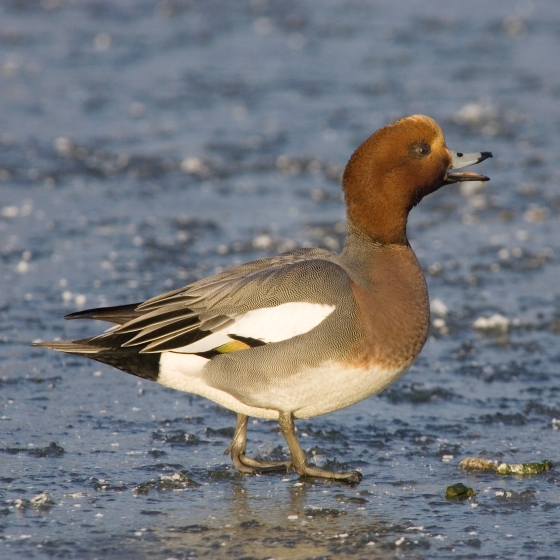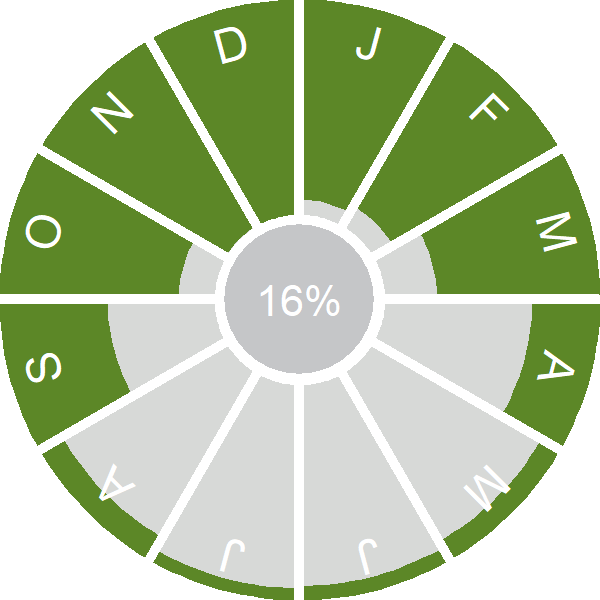Wigeon

Introduction
The male Wigeon is a pretty duck with his yellow forehead, contrasting chestnut head and neck, and pinks and greys of body plumage.
Our small breeding population is centred on the uplands and islands of northern Scotland and along the Pennine chain in England. The birds prefer small lochs with plenty of undisturbed upland vegetation nearby to feed the chicks.
In autumn, Britain & Ireland receive vast numbers of Wigeon from the breeding grounds located further north and this wintering population has increased significantly since 1983/84. The Wetland Bird Survey reveals a few widespread locations holding over 30,000 birds in winter.

Key Stats
Identification
Songs and Calls
Call:
Status and Trends
Conservation Status
Population Change
The Wigeon is best known to most UK birdwatchers as a winter visitor, especially to coastal marshes where it feeds in large flocks. However, small numbers bree,d mostly in Scotland and northern England. The mean number of pairs reported to the RBBP was 216 for the five-year period 2015–2019 but the species is under-reported and the recent and longer term trends are not known.
Distribution
In winter, there are concentrations of Wigeon in the Northern Isles, the inner Moray Firth, parts of central Scotland, the Irish Sea coastal fringe, major river valleys in eastern England, estuaries of south and southeast England and the rivers, lakes and turloughs of the west midlands of Ireland. The main breeding areas are in the Pennines and in northern Scotland.
Occupied 10-km squares in UK
or view it on Bird Atlas Mapstore.
or view it on Bird Atlas Mapstore.
European Distribution Map
Distribution Change
Change in occupied 10-km squares in the UK
or view it on Bird Atlas Mapstore.
or view it on Bird Atlas Mapstore.
Seasonality
Wigeons are common winter visitors, recorded on up to 20% of lists but scarce in summer when there is a small over-summering population and small numbers breed.
Weekly pattern of occurrence
The graph shows when the species is present in the UK, with taller bars indicating a higher likelihood of encountering the species in appropriate regions and habitats.

Movement
Britain & Ireland movement
Foreign locations of birds ringed or recovered in Britain & Ireland
Dots show the foreign destinations of birds ringed in Britain & Ireland, and the origins of birds ringed overseas that were subsequently recaptured, resighted or found dead in Britain & Ireland. Dot colours indicate the time of year that the species was present at the location.
- Winter (Nov-Feb)
- Spring (Mar-Apr)
- Summer (May-Jul)
- Autumn (Aug-Oct)

European movements
EuroBirdPortal uses birdwatcher's records, such as those logged in BirdTrack to map the flows of birds as they arrive and depart Europe. See maps for this species here.
The Eurasian-African Migration Atlas shows movements of individual birds ringed or recovered in Europe. See maps for this species here.
Biology
Productivity and Nesting
Nesting timing
Egg measurements
Clutch Size
Survival and Longevity
Survival is shown as the proportion of birds surviving from one year to the next and is derived from bird ringing data. It can also be used to estimate how long birds typically live.
View number ringed each year in the Online Ringing Report.
lifespan
Survival of adults
Biometrics
Wing length and body weights are from live birds (source).
Wing length
Body weight
Ring Size
Classification, names and codes
Classification and Codes
- Order: Anseriformes
- Family: Anatidae
- Scientific name: Mareca penelope
- Authority: Linnaeus, 1758
- BTO 2-letter code: WN
- BTO 5-letter code: WIGEO
- Euring code number: 1790
Alternate species names
- Catalan: ànec xiulador comú
- Czech: hvízdák eurasijský
- Danish: Pibeand
- Dutch: Smient
- Estonian: viupart
- Finnish: haapana
- French: Canard siffleur
- Gaelic: Glas-lach
- German: Pfeifente
- Hungarian: fütyülo réce
- Icelandic: Rauðhöfðaönd
- Irish: Rualacha
- Italian: Fischione
- Latvian: (baltvederis), švukškis
- Lithuanian: eurazine cyple
- Norwegian: Brunnakke
- Polish: swistun (zwyczajny)
- Portuguese: piadeira
- Slovak: kacica hvizdárka
- Slovenian: žvižgavka
- Spanish: Silbón europeo
- Swedish: bläsand
- Welsh: Chwiwell
- English folkname(s): Whistler, Half Duck
Research
Causes of Change and Solutions
Causes of change
The trends in the European flyway population since 1988 are believed to have been mostly caused by climatic effects, which influence breeding productivity and may also have a marginal effect on overwinter survival (Fox et al. 2016). Decreases in Equisetum stands on breeding lakes have also been suggested as a potential driver of declines in Sweden and Finland (Pöysa et al. 2017). In the absence of UK-specific information (or knowledge about the UK trends), it is not known whether climatic or habitat conditions or other factors may be influencing UK breeding population changes.

